Genome-Wide Identification and Expression Profile Analysis of the PHT1 Gene Family in Gossypium hirsutum and Its Two Close Relatives of Subgenome Donor Species
Abstract
1. Introduction
2. Results
2.1. PHT1 Genes in G. arboreum, G. raimondii and G. hirsutum
2.2. Structural Analysis of PHT1 Genes
2.3. Expansion of PHT1 Family Genes in Gossypium
2.4. Expression Patterns of PHT1 Genes in Gossypium
2.5. Expression of PHT1 Genes Induced by Low-Pi Treatment
3. Discussion
3.1. Homologues PHT1 Genes in G. arboreum, G. raimondii and G. hirsutum
3.2. PHT1 Gene Responses to P Deficiency in Cotton
4. Materials and Methods
4.1. Genome-Wide Identification of PHT1 Genes in Three Gossypium Species
4.2. Location and Structural Analysis of PHT1 Genes
4.3. Sequence Alignment and Phylogenetic Tree Construction
4.4. Analysis of Synteny and Duplication Types
4.5. P starvation Treatment
4.6. RNA Extraction and qRT-PCR
Supplementary Materials
Author Contributions
Acknowledgments
Conflicts of Interest
Abbreviations
| P | phosphorus |
| Pi | phosphate |
| PHT | phosphate transporter |
| MFS | Major Facilitator Superfamily |
| aa | amino acid |
| pIs | isoelectric points |
| ML | Maximum Likelihood |
| GSDS | Gene Structure Display Server |
| BBH | Bidirectional Best Hit |
| AMF | arbuscular mycorrhizal fungi |
| HMM | Hidden Markov Model |
| qRT-PCR | quantitative real time PCR |
| MEME | Multiple Em for Motif Elicitation |
| Ka | Non-synonymous substitution |
| Ks | Synonymous substitution |
References
- Bieleski, R.L. Phosphate Pools, Phosphate Transport, and Phosphate Availability. Annu. Rev. Plant Physiol. 1973, 24, 225–252. [Google Scholar] [CrossRef]
- Vance, C.P.; Uhde-Stone, C.; Allan, D.L. Phosphorus acquisition and use: Critical adaptations by plants for securing a nonrenewable resource. New Phytol. 2003, 157, 423–447. [Google Scholar] [CrossRef]
- Schachtman, D. Phosphorus Uptake by Plants: From Soil to Cell. Plant Physiol. 1998, 116, 447–453. [Google Scholar] [CrossRef] [PubMed]
- Wang, X.; Tang, C.; Guppy, C.; Sale, P.W.G. Phosphorus acquisition characteristics of cotton (Gossypium hirsutum L.), wheat (Triticum aestivum L.) and white lupin (Lupinus albus L.) under P deficient conditions. Plant Soil 2008, 312, 117–128. [Google Scholar] [CrossRef]
- Girma, K.; Teal, R.; Freeman, K.; Boman, R.; Raun, W. Cotton lint yield and quality as affected by applications of N, P, and K fertilizers. J. Cotton Sci. 2006, 11, 12–19. [Google Scholar]
- Nussaume, L.; Kanno, S.; Javot, H.; Marin, E.; Pochon, N.; Ayadi, A.; Nakanishi, T.M.; Thibaud, M.-C. Phosphate Import in Plants: Focus on the PHT1 Transporters. Front. Plant Sci. 2011, 2, 83. [Google Scholar] [CrossRef] [PubMed]
- Arredondo, D.L.; González, M.A.L.; González-Morales, S.I.; López-Bucio, J.; Herrera-Estrella, L. Phosphate Nutrition: Improving Low-Phosphate Tolerance in Crops. Annu. Rev. Plant Boil. 2014, 65, 95–123. [Google Scholar] [CrossRef]
- Shin, H.; Shin, H.-S.; Dewbre, G.R.; Harrison, M.J. Phosphate transport inArabidopsis: Pht1;1 and Pht1;4 play a major role in phosphate acquisition from both low- and high-phosphate environments. Plant J. 2004, 39, 629–642. [Google Scholar] [CrossRef]
- Rausch, C.; Bucher, M. Molecular mechanisms of phosphate transport in plants. Planta 2002, 216, 23–37. [Google Scholar] [CrossRef]
- Raghothama, K.G. Phosphate Acquisition. Annu. Rev. Plant Boil. 1999, 50, 665–693. [Google Scholar] [CrossRef]
- Raghothama, K. Phosphate transport and signaling. Curr. Opin. Plant Boil. 2000, 3, 182–187. [Google Scholar] [CrossRef]
- Ayadi, A.; David, P.; Arrighi, J.-F.; Chiarenza, S.; Thibaud, M.-C.; Nussaume, L.; Marín, E. Reducing the genetic redundancy of Arabidopsis PHOSPHATE TRANSPORTER1 transporters to study phosphate uptake and signaling. Plant Physiol. 2015, 167, 1511–1526. [Google Scholar] [CrossRef]
- Nagarajan, V.K.; Jain, A.; Poling, M.D.; Lewis, A.J.; Raghothama, K.G.; Smith, A.P. Arabidopsis Pht1;5 mobilizes phosphate between source and sink organs and influences the interaction between phosphate homeostasis and ethylene signaling. Plant Physiol. 2011, 156, 1149–1163. [Google Scholar] [CrossRef] [PubMed]
- Remy, E.; Cabrito, T.R.; A Batista, R.; Teixeira, M.; Sá-Correia, I.; Duque, P. The Pht1;9 and Pht1;8 transporters mediate inorganic phosphate acquisition by the Arabidopsis thaliana root during phosphorus starvation. New Phytol. 2012, 195, 356–371. [Google Scholar] [CrossRef] [PubMed]
- Paszkowski, U.; Kroken, S.; Roux, C.; Briggs, S.P. Rice phosphate transporters include an evolutionarily divergent gene specifically activated in arbuscular mycorrhizal symbiosis. Proc. Natl. Acad. Sci. USA 2002, 99, 13324–13329. [Google Scholar] [CrossRef] [PubMed]
- Sun, S.; Gu, M.; Cao, Y.; Huang, X.; Zhang, X.; Ai, P.; Zhao, J.; Fan, X.; Xu, G. A constitutive expressed phosphate transporter, OsPht1;1, modulates phosphate uptake and translocation in phosphate-replete rice. Plant Physiol. 2012, 159, 1571–1581. [Google Scholar] [CrossRef] [PubMed]
- Ai, P.; Sun, S.; Zhao, J.; Fan, X.; Xin, W.; Guo, Q.; Yu, L.; Shen, Q.; Wu, P.; Miller, A.J.; et al. Two rice phosphate transporters, OsPht1;2 and OsPht1;6, have different functions and kinetic properties in uptake and translocation. Plant J. 2009, 57, 798–809. [Google Scholar] [CrossRef] [PubMed]
- Ye, Y.; Yuan, J.; Chang, X.; Yang, M.; Zhang, L.; Lü, K.; Lian, X. The Phosphate Transporter Gene OsPht1;4 Is Involved in Phosphate Homeostasis in Rice. PLoS ONE 2015, 10, e0126186. [Google Scholar] [CrossRef] [PubMed]
- Li, Y.; Zhang, J.; Zhang, X.; Fan, H.; Gu, M.; Qu, H.; Xu, G. Phosphate transporter OsPht1;8 in rice plays an important role in phosphorus redistribution from source to sink organs and allocation between embryo and endosperm of seeds. Plant Sci. 2015, 230, 23–32. [Google Scholar] [CrossRef]
- Wang, X.; Wang, Y.; Piñeros, M.A.; Wang, Z.; Wang, W.; Li, C.; Wu, Z.; Kochian, L.; Wu, P. Phosphate transporters OsPHT1;9 and OsPHT1;10 are involved in phosphate uptake in rice. Plant Cell Environ. 2013, 37, 1159–1170. [Google Scholar] [CrossRef]
- Tamura, Y.; Kobae, Y.; Mizuno, T.; Hata, S. Identification and Expression Analysis of Arbuscular Mycorrhiza-Inducible Phosphate Transporter Genes of Soybean. Biosci. Biotechnol. Biochem. 2012, 76, 309–313. [Google Scholar] [CrossRef] [PubMed][Green Version]
- Qin, L.; Guo, Y.; Chen, L.; Liang, R.; Gu, M.; Xu, G.; Zhao, J.; Walk, T.; Liao, H. Functional Characterization of 14 Pht1 Family Genes in Yeast and Their Expressions in Response to Nutrient Starvation in Soybean. PLoS ONE 2012, 7, e47726. [Google Scholar] [CrossRef]
- Wu, Z.; Zhao, J.; Gao, R.; Hu, G.; Gai, J.; Xu, G.; Xing, H. Molecular Cloning, Characterization and Expression Analysis of Two Members of the Pht1 Family of Phosphate Transporters in Glycine max. PLoS ONE 2011, 6, e19752. [Google Scholar] [CrossRef] [PubMed]
- Qin, L.; Zhao, J.; Tian, J.; Chen, L.; Sun, Z.; Guo, Y.; Lu, X.; Gu, M.; Xu, G.; Liao, H. The high-affinity phosphate transporter GmPT5 regulates phosphate transport to nodules and nodulation in soybean. Plant Physiol. 2012, 159, 1634–1643. [Google Scholar] [CrossRef] [PubMed]
- Inoue, Y.; Kobae, Y.; Omoto, E.; Tanaka, A.; Banba, M.; Takai, S.; Tamura, Y.; Hirose, A.; Komatsu, K.; Otagaki, S.; et al. The Soybean Mycorrhiza-Inducible Phosphate Transporter Gene, GmPT7, also Shows Localized Expression at the Tips of Vein Endings of Senescent Leaves. Plant Cell Physiol. 2014, 55, 2102–2111. [Google Scholar] [CrossRef] [PubMed]
- Chen, A.; Chen, X.; Wang, H.; Liao, D.; Gu, M.; Qu, H.; Sun, S.; Xu, G. Genome-wide investigation and expression analysis suggest diverse roles and genetic redundancy of Pht1 family genes in response to Pi deficiency in tomato. BMC Plant Boil. 2014, 14, 61. [Google Scholar] [CrossRef]
- Nagy, R.; Vasconcelos, M.J.V.; Zhao, S.; McElver, J.; Bruce, W.; Amrhein, N.; Raghothama, K.G.; Bucher, M. Differential Regulation of Five Pht1 Phosphate Transporters from Maize (Zea mays L.). Plant Boil. 2006, 8, 186–197. [Google Scholar] [CrossRef]
- Liu, J.; Versaw, W.K.; Pumplin, N.; Gomez, S.K.; Blaylock, L.A.; Harrison, M.J. Closely related members of the Medicago truncatula PHT1 phosphate transporter gene family encode phosphate transporters with distinct biochemical activities. J. Boil. Chem. 2008, 283, 24673–24681. [Google Scholar] [CrossRef] [PubMed]
- Guo, C.; Guo, L.; Li, X.; Gu, J.; Zhao, M.; Duan, W.; Ma, C.; Lu, W.; Xiao, K. TaPT2, a high-affinity phosphate transporter gene in wheat (Triticum aestivum L.), is crucial in plant Pi uptake under phosphorus deprivation. Acta Physiol. Plant. 2014, 36, 1373–1384. [Google Scholar] [CrossRef]
- Liu, B.; Zhao, S.; Wu, X.; Wang, X.; Nan, Y.; Wang, N.; Chen, Q. Identification and characterization of phosphate transporter genes in potato. J. Biotechnol. 2017, 264, 17–28. [Google Scholar] [CrossRef]
- Walder, F.; Brulé, D.; Koegel, S.; Wiemken, A.; Boller, T.; Courty, P.-E. Plant phosphorus acquisition in a common mycorrhizal network: Regulation of phosphate transporter genes of the Pht1 family in sorghum and flax. New Phytol. 2015, 205, 1632–1645. [Google Scholar] [CrossRef] [PubMed]
- Liu, P.; Chen, S.; Song, A.; Zhao, S.; Fang, W.; Guan, Z.; Liao, Y.; Jiang, J.; Chen, F. A putative high affinity phosphate transporter, CmPT1, enhances tolerance to Pi deficiency of chrysanthemum. BMC Plant Boil. 2014, 14, 18. [Google Scholar] [CrossRef]
- Parra-Almuna, L.; Pontigo, S.; Larama, G.; Cumming, J.R.; Pérez-Tienda, J.; Ferrol, N.; Mora, M.D.L.L. Expression analysis and functional characterization of two PHT1 family phosphate transporters in ryegrass. Planta 2019, 251, 6. [Google Scholar] [CrossRef] [PubMed]
- Wendel, J.F.; Flagel, L.; Adams, K.L. Jeans, Genes, and Genomes: Cotton as a Model for Studying Polyploidy. Polyploidy Genome Evolut. 2012, 10, 181–207. [Google Scholar] [CrossRef]
- Wendel, J.F.; Cronn, R.C. Polyploidy and the evolutionary history of cotton. Adv. Agron. 2003, 78, 139–186. [Google Scholar] [CrossRef]
- Wang, M.; Tu, L.; Lin, M.; Lin, Z.; Wang, P.; Yang, Q.; Ye, Z.; Shen, C.; Li, J.; Zhang, L.; et al. Asymmetric subgenome selection and cis-regulatory divergence during cotton domestication. Nat. Genet. 2017, 49, 579–587. [Google Scholar] [CrossRef]
- Chao, M.; Zhang, Z.; Song, H.; Li, C.; Zhang, X.; Hu, G.; Zhang, J.; Wang, Q. Genome-Wide Identification and Expression Analysis of Pht1 Family Genes in Cotton (Gossypium hirsutum L.). J. Cotton Sci. 2017, 29, 59–69. [Google Scholar]
- Mueckler, M.; Caruso, C.; Baldwin, S.; Panico, M.; Blench, I.; Morris, H.; Allard, W.; Lienhard, G.; Lodish, H. Sequence and structure of a human glucose transporter. Science 1985, 229, 941–945. [Google Scholar] [CrossRef] [PubMed]
- Poirier, Y.; Bucher, M. Phosphate Transport and Homeostasis in Arabidopsis. Arab. Book 2002, 1, e0024. [Google Scholar] [CrossRef]
- Rizzon, C.; Ponger, L.; Gaut, B.S. Striking Similarities in the Genomic Distribution of Tandemly Arrayed Genes in Arabidopsis and Rice. PLoS Comput. Boil. 2006, 2, e115. [Google Scholar] [CrossRef]
- Wang, Y.; Tang, H.; DeBarry, J.D.; Tan, X.; Li, J.; Wang, X.; Lee, T.-H.; Jin, H.; Marler, B.; Guo, H.; et al. MCScanX: A toolkit for detection and evolutionary analysis of gene synteny and collinearity. Nucleic Acids Res. 2012, 40, e49. [Google Scholar] [CrossRef] [PubMed]
- Krzywinski, M.; Schein, J.; Birol, I.; Connors, J.; Gascoyne, R.; Horsman, D.; Jones, S.J.M.; Marra, M.A. Circos: An information aesthetic for comparative genomics. Genome Res. 2009, 19, 1639–1645. [Google Scholar] [CrossRef] [PubMed]
- Van Der Graaff, E.; Schwacke, R.; Schneider, A.; DeSimone, M.; Flügge, U.-I.; Kunze, R. Transcription Analysis of Arabidopsis Membrane Transporters and Hormone Pathways during Developmental and Induced Leaf Senescence. Plant Physiol. 2006, 141, 776–792. [Google Scholar] [CrossRef] [PubMed]
- Al-Ghazi, Y.; Muller, B.; Pinloche, S.; Tranbarger, T.J.; Nacry, P.; Rossignol, M.; Tardieu, F.; Doumas, P. Temporal responses of Arabidopsis root architecture to phosphate starvation: Evidence for the involvement of auxin signalling. Plant Cell Environ. 2003, 26, 1053–1066. [Google Scholar] [CrossRef]
- Student. The Probable Error of a Mean; Biometrika: Oxford, UK, 1908; Volume 6, pp. 1–25. [Google Scholar]
- Hu, Y.; Chen, J.-D.; Fang, L.; Zhang, Z.; Ma, W.; Niu, Y.; Ju, L.; Deng, J.; Zhao, T.; Lian, J.; et al. Gossypium barbadense and Gossypium hirsutum genomes provide insights into the origin and evolution of allotetraploid cotton. Nat. Genet. 2019, 51, 739–748. [Google Scholar] [CrossRef] [PubMed]
- Zhang, T.; Hu, Y.; Jiang, W.-K.; Fang, L.; Guan, X.; Chen, J.-D.; Zhang, J.; A Saski, C.; Scheffler, B.E.; Stelly, D.M.; et al. Sequencing of allotetraploid cotton (Gossypium hirsutum L. acc. TM-1) provides a resource for fiber improvement. Nat. Biotechnol. 2015, 33, 531–537. [Google Scholar] [CrossRef]
- Hanada, K.; Zou, C.; Lehti-Shiu, M.D.; Shinozaki, K.; Shiu, S.-H. Importance of Lineage-Specific Expansion of Plant Tandem Duplicates in the Adaptive Response to Environmental Stimuli1[W][OA]. Plant Physiol. 2008, 148, 993–1003. [Google Scholar] [CrossRef]
- Krishna, S.S.; Majumdar, I.; Grishin, N.V. Structural classification of zinc fingers: Survey and Summary. Nucleic Acids Res. 2003, 31, 532–550. [Google Scholar] [CrossRef]
- Schünmann, P.H.D.; Richardson, A.E.; Smith, F.W.; Delhaize, E. Characterization of promoter expression patterns derived from the Pht1 phosphate transporter genes of barley (Hordeum vulgare L.). J. Exp. Bot. 2004, 55, 855–865. [Google Scholar] [CrossRef]
- Ren, F.; Zhao, C.-Z.; Liu, C.-S.; Huang, K.-L.; Guo, Q.-Q.; Chang, L.-L.; Xiong, H.; Li, X. A Brassica napus PHT1 phosphate transporter, BnPht1;4, promotes phosphate uptake and affects roots architecture of transgenic Arabidopsis. Plant Mol. Boil. 2014, 86, 595–607. [Google Scholar] [CrossRef]
- Chen, A.; Gu, M.; Sun, S.; Hong, S.; Zhu, L.; Xu, G. Identification of two conserved cis-acting elements, MYCS and P1BS, involved in the regulation of mycorrhiza-activated phosphate transporters in eudicot species. New Phytol. 2010, 189, 1157–1169. [Google Scholar] [CrossRef]
- Poulsen, K.H.; Nagy, R.; Gao, L.-L.; Smith, S.E.; Bucher, M.; Smith, F.A.; Jakobsen, I. Physiological and molecular evidence for Pi uptake via the symbiotic pathway in a reduced mycorrhizal colonization mutant in tomato associated with a compatible fungus. New Phytol. 2005, 168, 445–454. [Google Scholar] [CrossRef] [PubMed]
- Chen, A.; Hu, J.; Sun, S.; Xu, G. Conservation and divergence of both phosphate- and mycorrhiza-regulated physiological responses and expression patterns of phosphate transporters in solanaceous species. New Phytol. 2007, 173, 817–831. [Google Scholar] [CrossRef] [PubMed]
- Wang, K.; Wang, Z.; Li, F.; Ye, W.; Wang, J.; Song, G.; Yue, Z.; Cong, L.; Shang, H.; Zhu, S.; et al. The draft genome of a diploid cotton Gossypium raimondii. Nat. Genet. 2012, 44, 1098–1103. [Google Scholar] [CrossRef] [PubMed]
- Thompson, J.D.; Gibson, T.J.; Higgins, D.G. Multiple Sequence Alignment Using ClustalW and ClustalX. Curr. Protoc. Bioinform. 2002, 2, 2.3.1–2.3.22. [Google Scholar] [CrossRef] [PubMed]
- Voorrips, R.E. MapChart: Software for the graphical presentation of linkage maps and QTLs. J. Hered. 2002, 93, 77–78. [Google Scholar] [CrossRef]
- Hu, B.; Jin, J.; Guo, A.-Y.; Zhang, H.; Luo, J.; Gao, G. GSDS 2.0: An upgraded gene feature visualization server. Bioinformtics 2014, 31, 1296–1297. [Google Scholar] [CrossRef]
- Bailey, T.L.; Bodén, M.; Buske, F.A.; Frith, M.; Grant, C.E.; Clementi, L.; Ren, J.; Li, W.W.; Noble, W.S. MEME SUITE: Tools for motif discovery and searching. Nucleic Acids Res. 2009, 37, W202–W208. [Google Scholar] [CrossRef]
- Chen, C.; Xia, R.; Chen, H.; He, Y. TBtools, a Toolkit for Biologists integrating various HTS-data handling tools with a user-friendly interface. bioRxiv 2018, 10, 289660. [Google Scholar] [CrossRef]
- Lescot, M. PlantCARE, a database of plant cis-acting regulatory elements and a portal to tools for in silico analysis of promoter sequences. Nucleic Acids Res. 2002, 30, 325–327. [Google Scholar] [CrossRef]
- Kumar, S.; Stecher, G.; Li, M.; Knyaz, C.; Tamura, K. MEGA X: Molecular Evolutionary Genetics Analysis across Computing Platforms. Mol. Boil. Evol. 2018, 35, 1547–1549. [Google Scholar] [CrossRef] [PubMed]
- Letunic, I.; Bork, P. Interactive Tree Of Life (iTOL) v4: Recent updates and new developments. Nucleic Acids Res. 2019, 47, W256–W259. [Google Scholar] [CrossRef] [PubMed]
- Wang, D.; Zhang, Y.; Zhang, Z.; Zhu, J.; Yu, J. KaKs_Calculator 2.0: A Toolkit Incorporating Gamma-Series Methods and Sliding Window Strategies. Genom. Proteom. Bioinform. 2010, 8, 77–80. [Google Scholar] [CrossRef]
- Du, X.; Huang, G.; He, S.; Yang, Z.; Sun, G.; Ma, X.; Li, N.; Zhang, X.; Sun, J.; Liu, M.; et al. Resequencing of 243 diploid cotton accessions based on an updated A genome identifies the genetic basis of key agronomic traits. Nat. Genet. 2018, 50, 796–802. [Google Scholar] [CrossRef]
- Dong, Q.; Zhou, Z.; Cai, X.; Lu, P.; Kirungu, J.N.; Zhou, Z.; Wang, X.; Wang, X.; Xu, Y.; Hou, Y.; et al. RNA-Sequencing, Physiological and RNAi Analyses Provide Insights into the Response Mechanism of the ABC-Mediated Resistance to Verticillium dahliae Infection in Cotton. Genes 2019, 10, 110. [Google Scholar] [CrossRef]
- Jiang, J.X.; Zhang, T. Extraction of Total RNA in Cotton Tissues with CTAB-acidic Phenolic Method. Cotton Sci. 2003, 15, 166–167. [Google Scholar]
- Wittwer, C.T.; Herrmann, M.G.; Moss, A.A.; Rasmussen, R.P. Continuous Fluorescence Monitoring of Rapid Cycle DNA Amplification. Biotechniques 1997, 22, 130–138. [Google Scholar] [CrossRef]
- Livak, K.J.; Schmittgen, T.D. Analysis of Relative Gene Expression Data Using Real-Time Quantitative PCR and the 2−ΔΔCT. Methods 2001, 25, 402–408. [Google Scholar] [CrossRef]
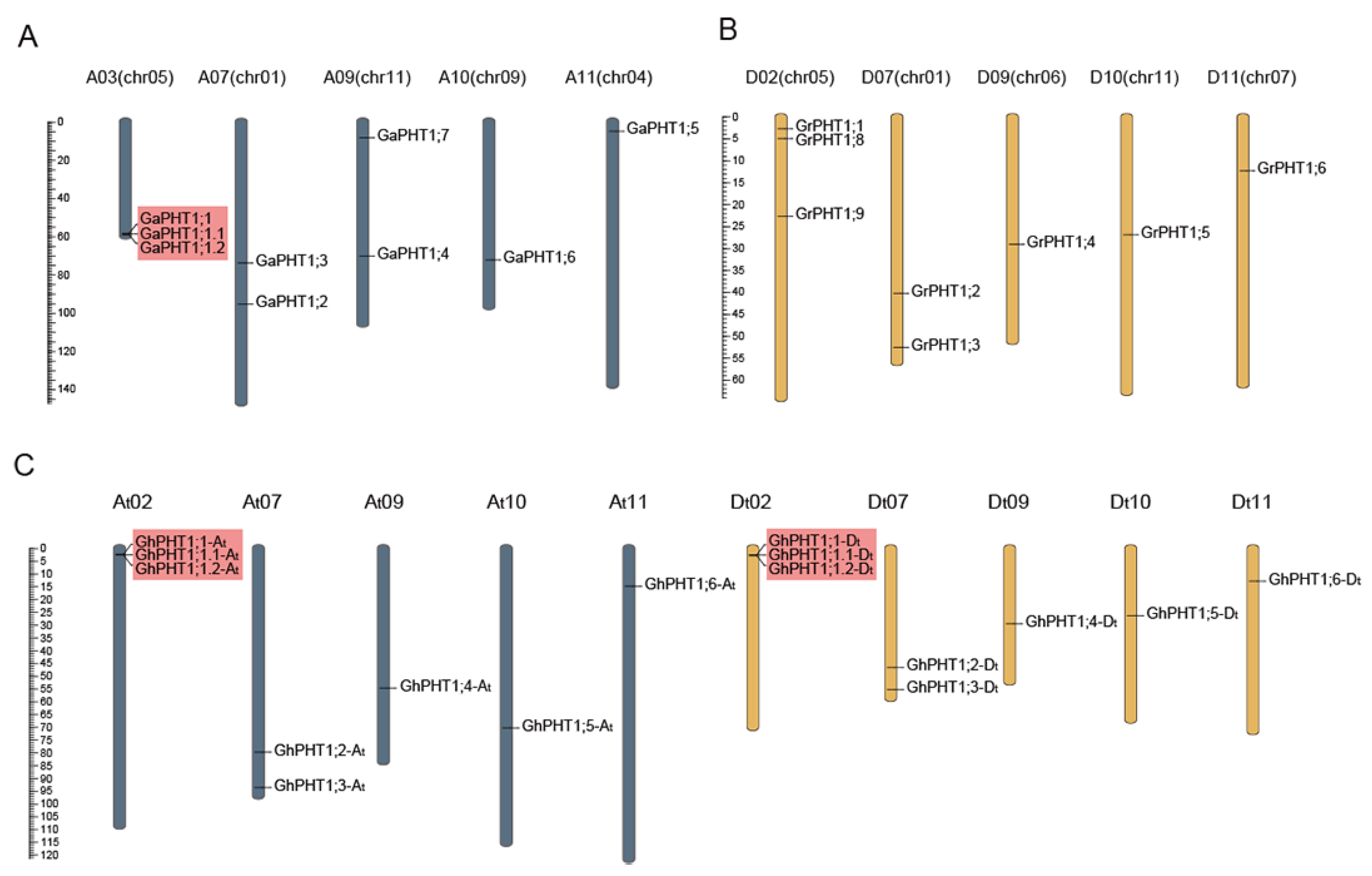

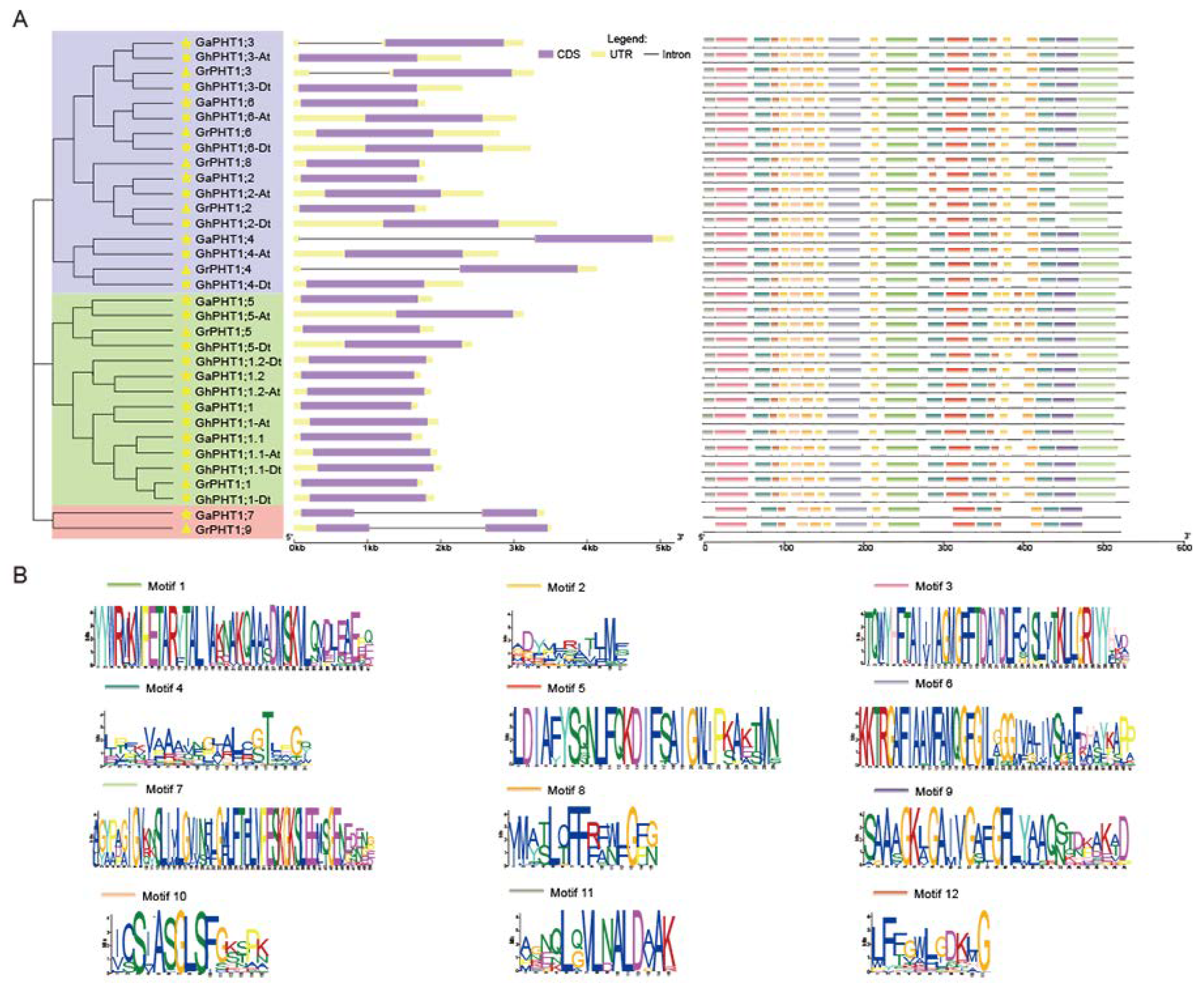

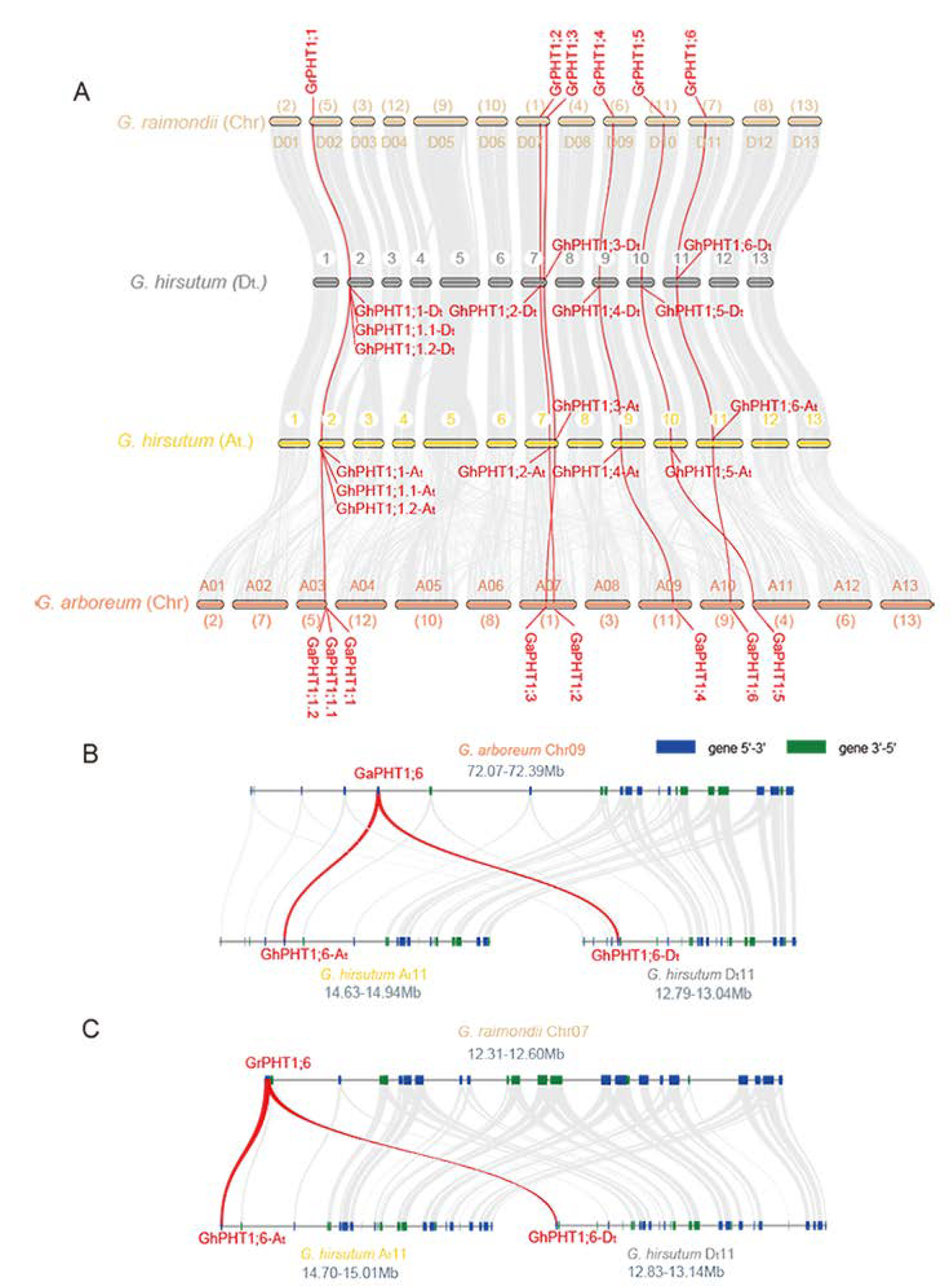
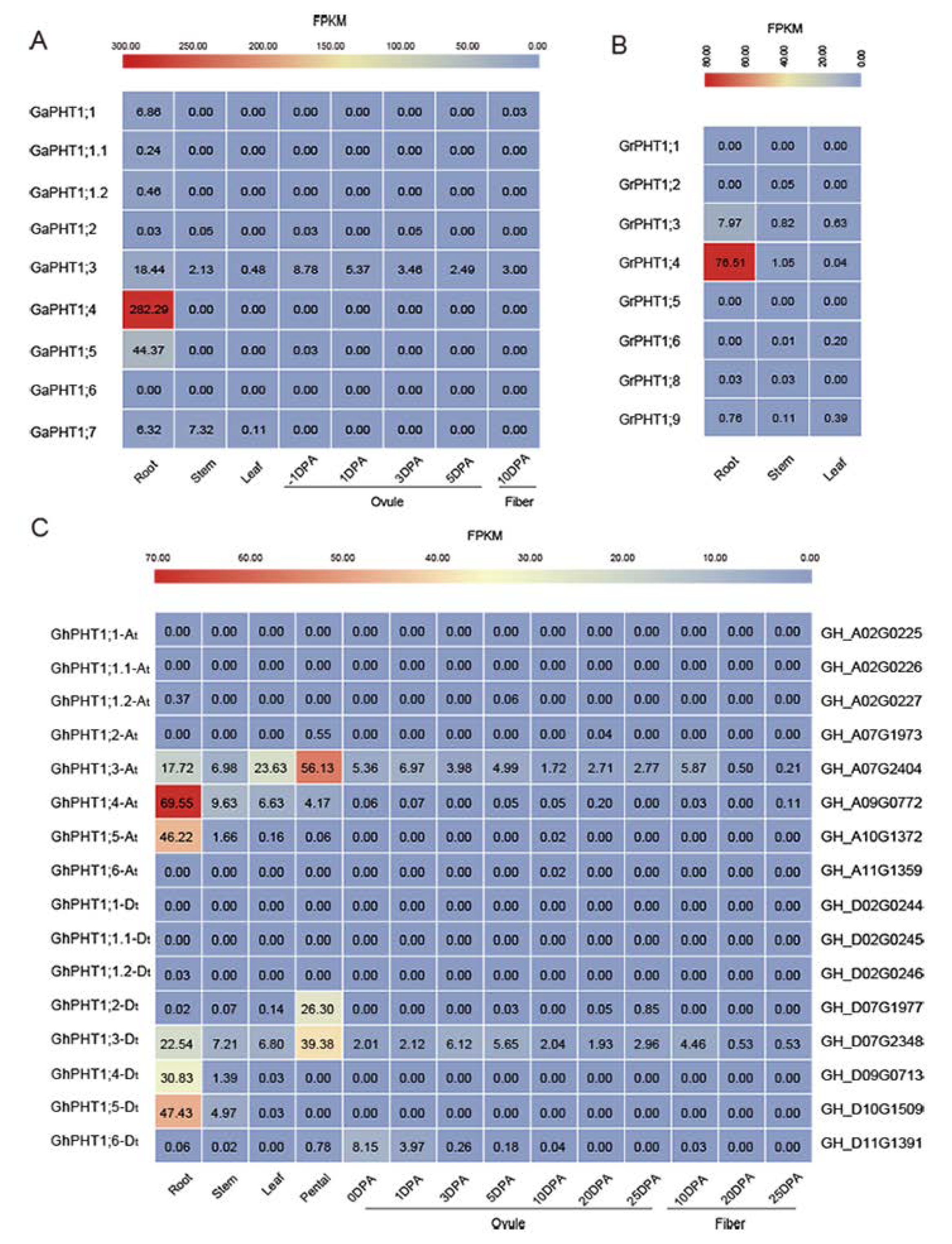
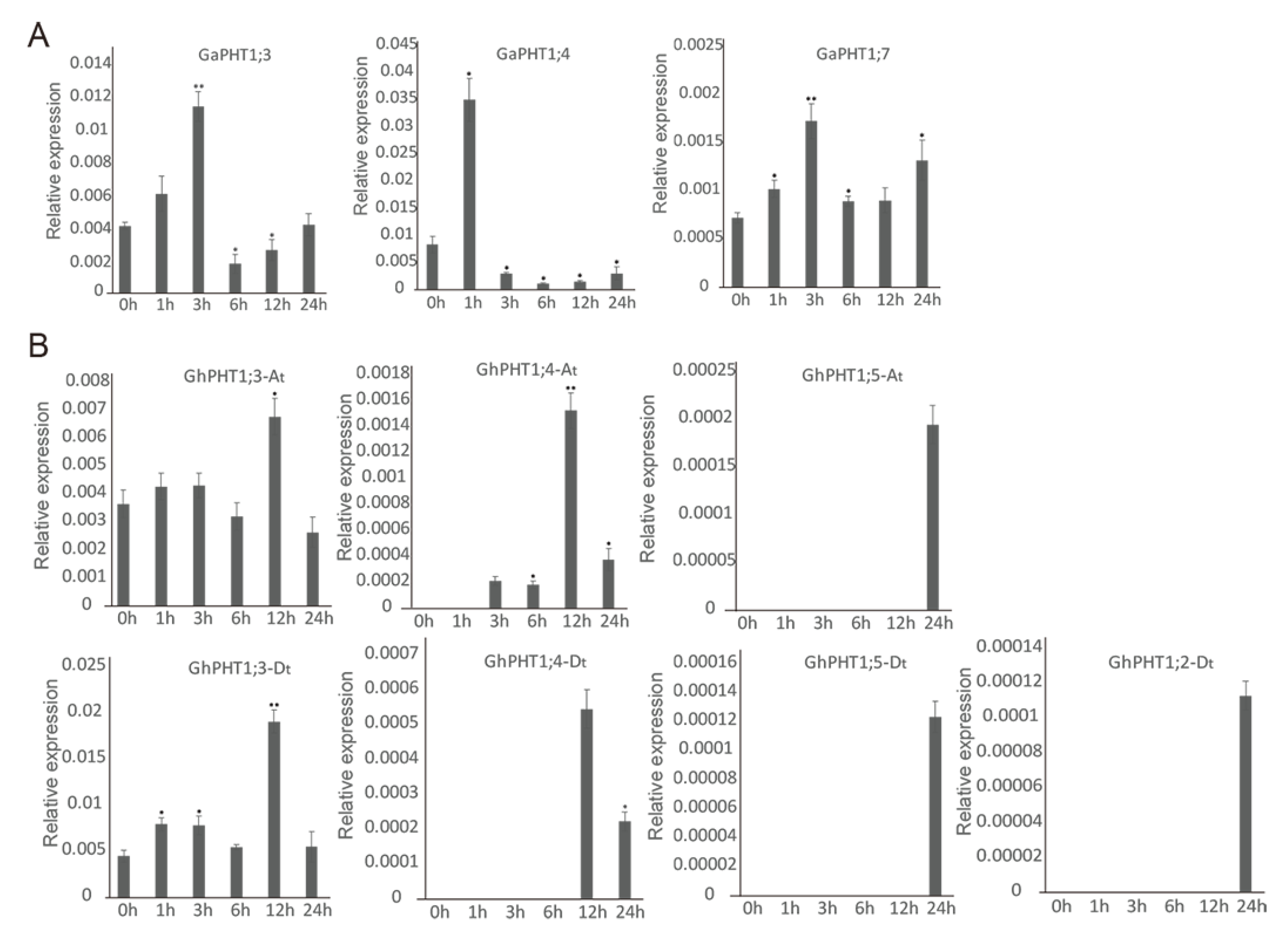
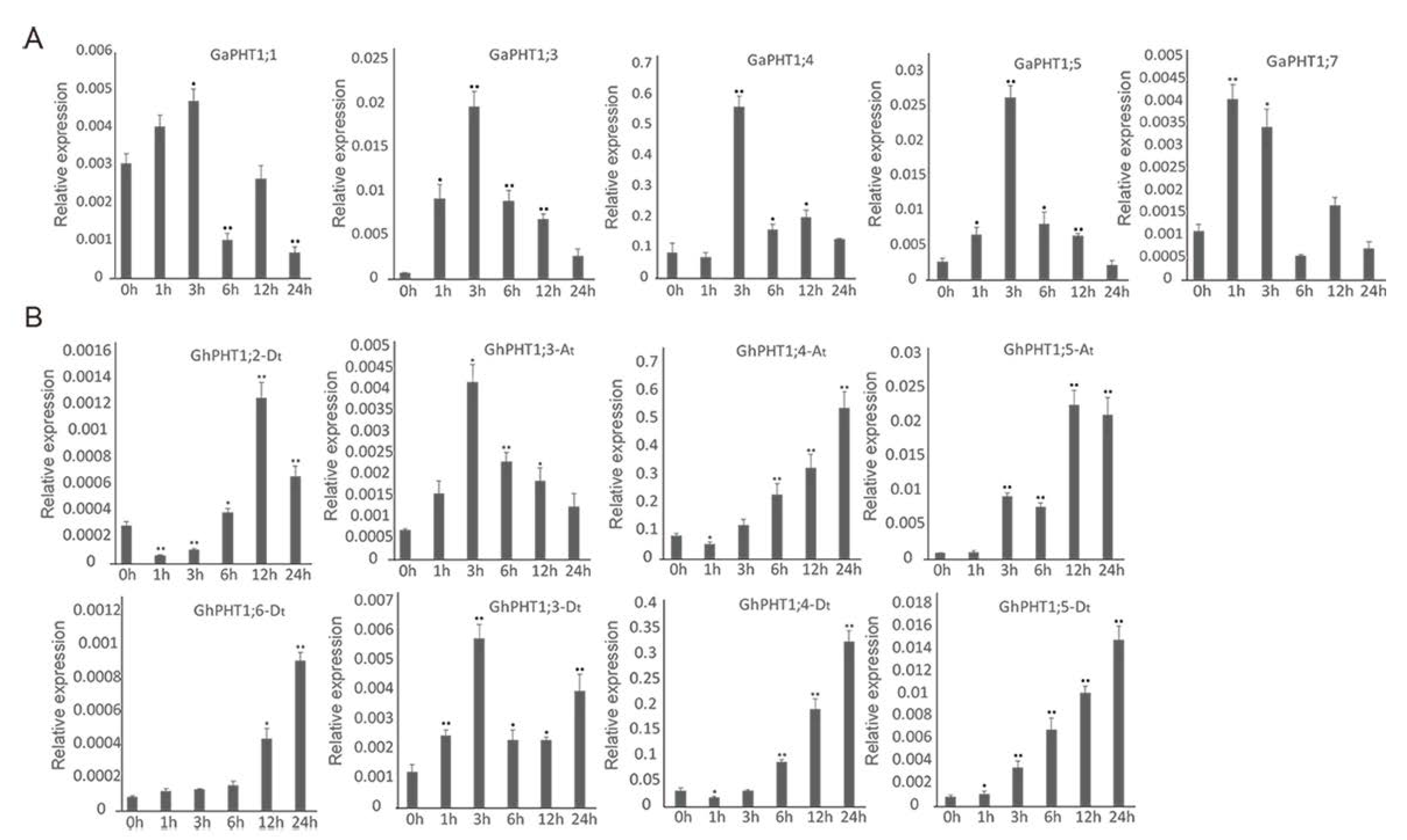
| Species | Name | Gene ID | Number of Amino Acid | Molecular Weight (kDa) | Isoelectric Point |
|---|---|---|---|---|---|
| G. arboreum | GaPHT1;1 | 108475583 | 531 | 58.14 | 9.06 |
| GaPHT1;1.1 | 108475338 | 529 | 58.08 | 8.90 | |
| GaPHT1;1.2 | 108475339 | 529 | 58.10 | 8.69 | |
| GaPHT1;2 | 108477504 | 527 | 57.84 | 9.12 | |
| GaPHT1;3 | 108462460 | 540 | 59.15 | 8.79 | |
| GaPHT1;4 | 108454927 | 537 | 58.51 | 8.85 | |
| GaPHT1;5 | 108472823 | 533 | 58.07 | 8.07 | |
| GaPHT1;6 | 108488770 | 533 | 58.10 | 8.66 | |
| GaPHT1;7 | 108454997 | 524 | 58.13 | 9.05 | |
| G. hirsutum | GhPHT1;1-At | GH_A02G0225 | 529 | 58.27 | 8.69 |
| GhPHT1;1.1-At | GH_A02G0226 | 529 | 58.20 | 8.68 | |
| GhPHT1;1.2-At | GH_A02G0227 | 531 | 58.29 | 8.99 | |
| GhPHT1;2-At | GH_A07G1973 | 527 | 57.86 | 9.24 | |
| GhPHT1;3-At | GH_A07G2404 | 540 | 59.14 | 8.78 | |
| GhPHT1;4-At | GH_A09G0772 | 537 | 58.56 | 8.73 | |
| GhPHT1;5-At | GH_A10G1372 | 533 | 58.10 | 8.07 | |
| GhPHT1;6-At | GH_A11G1359 | 533 | 58.14 | 8.66 | |
| GhPHT1;1-Dt | GH_D02G0244 | 529 | 58.16 | 8.99 | |
| GhPHT1;1.1-Dt | GH_D02G0245 | 529 | 58.21 | 8.78 | |
| GhPHT1;1.2-Dt | GH_D02G0246 | 531 | 58.15 | 8.99 | |
| GhPHT1;2-Dt | GH_D07G1977 | 525 | 57.74 | 9.29 | |
| GhPHT1;3-Dt | GH_D07G2348 | 540 | 59.23 | 8.67 | |
| GhPHT1;4-Dt | GH_D09G0713 | 537 | 58.50 | 8.94 | |
| GhPHT1;5-Dt | GH_D10G1509 | 533 | 58.11 | 8.07 | |
| GhPHT1;6-Dt | GH_D11G1391 | 533 | 58.10 | 8.78 | |
| G. raimondii | GrPHT1;1 | 105796073 | 529 | 58.22 | 8.98 |
| GrPHT1;2 | 105801425 | 525 | 57.77 | 9.25 | |
| GrPHT1;3 | 105767689 | 540 | 59.19 | 8.79 | |
| GrPHT1;4 | 105798813 | 537 | 58.54 | 8.98 | |
| GrPHT1;5 | 105774918 | 533 | 58.11 | 8.08 | |
| GrPHT1;6 | 105803201 | 533 | 58.16 | 8.66 | |
| GrPHT1;8 | 105796728 | 513 | 56.74 | 9.08 | |
| GrPHT1;9 | 105793869 | 524 | 58.19 | 9.17 |
| Homoeologous Genes | Ka | Ks | Ka/Ks |
|---|---|---|---|
| GaPHT1;1-GhPHT1;1-At | 0.0367 | 0.1208 | 0.3039 |
| GaPHT1;1.1-GhPHT1;1.1-At | 0.0247 | 0.0677 | 0.3646 |
| GaPHT1;1.2-GhPHT1;1.2-At | 0.0308 | 0.1214 | 0.2541 |
| GaPHT1;2-GhPHT1;2-At | 0.0032 | 0.0111 | 0.2851 |
| GaPHT1;3-GhPHT1;3-At | 0.0026 | 0.0094 | 0.2798 |
| GaPHT1;4-GhPHT1;4-At | 0.0066 | 0.0179 | 0.3662 |
| GaPHT1;5-GhPHT1;5-At | 0.0009 | 0.0103 | 0.0867 |
| GaPHT1;6-GhPHT1;6-At | 0.0017 | 0.0046 | 0.3665 |
| GrPHT1;1-GhPHT1;1-Dt | 0.0076 | 0.0357 | 0.2130 |
| GrPHT1;2-GhPHT1;2-Dt | 0.0025 | 0.0029 | 0.8520 |
| GrPHT1;3-GhPHT1;3-Dt | 0.0024 | 0.0053 | 0.4559 |
| GrPHT1;4-GhPHT1;4-Dt | 1.0542 | 0.8497 | 1.2407 |
| GrPHT1;5-GhPHT1;5-Dt | 0.0017 | 0.0146 | 0.1149 |
| GrPHT1;6-GhPHT1;6-Dt | 0.0008 | 0.0029 | 0.2800 |
© 2020 by the authors. Licensee MDPI, Basel, Switzerland. This article is an open access article distributed under the terms and conditions of the Creative Commons Attribution (CC BY) license (http://creativecommons.org/licenses/by/4.0/).
Share and Cite
Cai, S.; Liu, F.; Zhou, B. Genome-Wide Identification and Expression Profile Analysis of the PHT1 Gene Family in Gossypium hirsutum and Its Two Close Relatives of Subgenome Donor Species. Int. J. Mol. Sci. 2020, 21, 4905. https://doi.org/10.3390/ijms21144905
Cai S, Liu F, Zhou B. Genome-Wide Identification and Expression Profile Analysis of the PHT1 Gene Family in Gossypium hirsutum and Its Two Close Relatives of Subgenome Donor Species. International Journal of Molecular Sciences. 2020; 21(14):4905. https://doi.org/10.3390/ijms21144905
Chicago/Turabian StyleCai, Sheng, Fujie Liu, and Baoliang Zhou. 2020. "Genome-Wide Identification and Expression Profile Analysis of the PHT1 Gene Family in Gossypium hirsutum and Its Two Close Relatives of Subgenome Donor Species" International Journal of Molecular Sciences 21, no. 14: 4905. https://doi.org/10.3390/ijms21144905
APA StyleCai, S., Liu, F., & Zhou, B. (2020). Genome-Wide Identification and Expression Profile Analysis of the PHT1 Gene Family in Gossypium hirsutum and Its Two Close Relatives of Subgenome Donor Species. International Journal of Molecular Sciences, 21(14), 4905. https://doi.org/10.3390/ijms21144905






